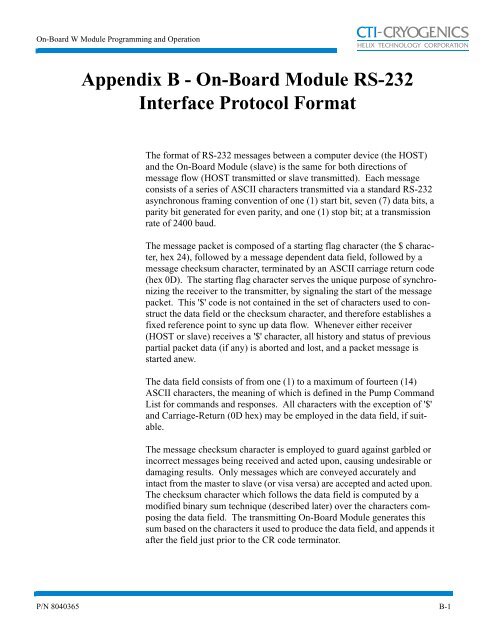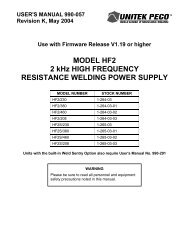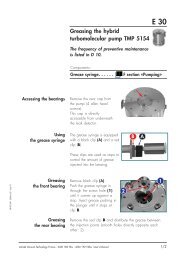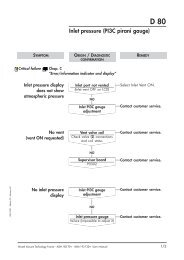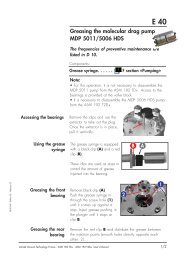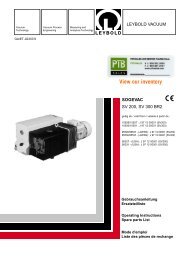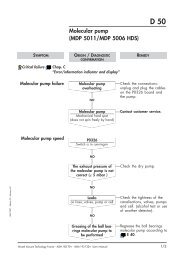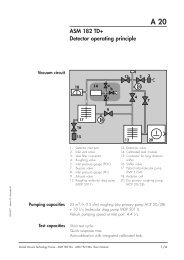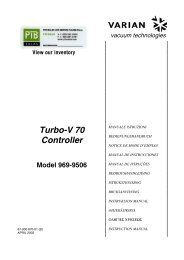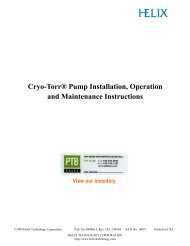On-Board® W Module Programming and Operation ... - PTB Sales
On-Board® W Module Programming and Operation ... - PTB Sales
On-Board® W Module Programming and Operation ... - PTB Sales
You also want an ePaper? Increase the reach of your titles
YUMPU automatically turns print PDFs into web optimized ePapers that Google loves.
<strong>On</strong>-Board W <strong>Module</strong> <strong>Programming</strong> <strong>and</strong> <strong>Operation</strong><br />
CTI-CRYOGENICS<br />
HELIX TECHNOLOGY CORPORATION<br />
Appendix B - <strong>On</strong>-Board <strong>Module</strong> RS-232<br />
Interface Protocol Format<br />
The format of RS-232 messages between a computer device (the HOST)<br />
<strong>and</strong> the <strong>On</strong>-Board <strong>Module</strong> (slave) is the same for both directions of<br />
message flow (HOST transmitted or slave transmitted). Each message<br />
consists of a series of ASCII characters transmitted via a st<strong>and</strong>ard RS-232<br />
asynchronous framing convention of one (1) start bit, seven (7) data bits, a<br />
parity bit generated for even parity, <strong>and</strong> one (1) stop bit; at a transmission<br />
rate of 2400 baud.<br />
The message packet is composed of a starting flag character (the $ character,<br />
hex 24), followed by a message dependent data field, followed by a<br />
message checksum character, terminated by an ASCII carriage return code<br />
(hex 0D). The starting flag character serves the unique purpose of synchronizing<br />
the receiver to the transmitter, by signaling the start of the message<br />
packet. This '$' code is not contained in the set of characters used to construct<br />
the data field or the checksum character, <strong>and</strong> therefore establishes a<br />
fixed reference point to sync up data flow. Whenever either receiver<br />
(HOST or slave) receives a '$' character, all history <strong>and</strong> status of previous<br />
partial packet data (if any) is aborted <strong>and</strong> lost, <strong>and</strong> a packet message is<br />
started anew.<br />
The data field consists of from one (1) to a maximum of fourteen (14)<br />
ASCII characters, the meaning of which is defined in the Pump Comm<strong>and</strong><br />
List for comm<strong>and</strong>s <strong>and</strong> responses. All characters with the exception of '$'<br />
<strong>and</strong> Carriage-Return (0D hex) may be employed in the data field, if suitable.<br />
The message checksum character is employed to guard against garbled or<br />
incorrect messages being received <strong>and</strong> acted upon, causing undesirable or<br />
damaging results. <strong>On</strong>ly messages which are conveyed accurately <strong>and</strong><br />
intact from the master to slave (or visa versa) are accepted <strong>and</strong> acted upon.<br />
The checksum character which follows the data field is computed by a<br />
modified binary sum technique (described later) over the characters composing<br />
the data field. The transmitting <strong>On</strong>-Board <strong>Module</strong> generates this<br />
sum based on the characters it used to produce the data field, <strong>and</strong> appends it<br />
after the field just prior to the CR code terminator.<br />
P/N 8040365 B-1


